Sourdough Bread Bowls
This post may contain affiliate links. Please read our disclosure policy.Soup season is here, and you know what that means – it’s time for the ultimate comfort food pairing: a steaming bowl of soup nestled in a crusty sourdough bread bowl. Honestly, it might just be my absolute favorite thing about this season. There’s something truly magical about the way a warm, savory soup complements the rustic charm and aroma of freshly baked sourdough bread. It’s a pairing that warms not only the body but also the heart, making those chilly autumn days all the more delightful. Grab the recipe to make these sourdough bread bowls today.

Important Ingredients in Sourdough Bread Bowls
Sourdough Starter: Use an active/ripe sourdough starter (doubled in size/bubbly/mild sour aroma) to mix the levain.
Bread Flour: I almost always use a 12.5% protein bread flour for any bread that I am kneading. The higher protein content and properly activating the gluten results in a lighter/springy baked good.
Salt: Salt enhances flavor and works with the yeast to produce the best fermentation. Don’t forget to add it!
Water: Temperature is very important to how sourdough ferments. Following the temperature recommendations in this recipe will help this dough rise and ferment properly.
Ice Cubes for Baking: I use ice cubes as an easy way to steam my oven for an open bake. You can bake these bread bowls in a dutch oven instead, but it will take a long time unless you have multiple dutch ovens.

Sample Sourdough Bread Bowl Schedule
A sample baking schedule helps me when baking with sourdough. Sourdough takes much longer to rise than traditional bread. This schedule helps me plan my bake.
Note: This schedule assumes the dough temperature will be maintained at 78-80 degrees F (or a little higher) throughout the process.
| Day 1 | Levain |
| 8;00 PM – 8:00 AM | Mix Levain (1:10:10, overnight/10-12 hours before peak) |
| Day 2 | Mix Dough/Bulk Fermentation/Cold Bulk Fermentation |
| 8:00 AM | Mix Dough |
| 9:00 AM | 1st Stretch and Fold |
| 10:00 AM | 2nd Stretch and Fold |
| 11:00 AM | 3rd Stretch and Fold |
| 12:00 PM | Refrigerate Dough |
| Day 3 | Shape and Bake |
| 8:00 AM | Shape dough into balls. Let rest for 2 hours. |
| 10:00 AM | Score and Bake |


Mixing the Levain
- Make the levain the night before. Take 22 grams of ripe/bubbly/active sourdough starter. Feed it 220 grams flour and 220 grams water. Cover and let sit overnight until doubled in size, bubbly and peaks. If your starter is kept at 78 degrees, this should take about 10-12 hours.
Questions about why I use a levain method? Get them answered here:
Mixing Up Dough for Sourdough Bread Bowls
To a large mixing bowl, add the ripe levain, flour, water and salt. If your kitchen is cold and your ingredients are cold, use warm water. If your kitchen is warm and your ingredients are warm, you may need to use cool water. You can take the temperature of your ingredients with a thermometer to know for sure. The dough should be kept right around 78-80 degrees F for best fermentation. Read this for more information on how temperature affects sourdough. Mix together with a dough whisk or your hands until a shaggy dough forms.



Bulk Fermentation
Bulk fermentation is the time right after the dough has been mixed until it is baked. I like to split my bulk fermentation into two parts: Bulk Fermentation (at warm room temperature, 78 F) and Cold Bulk Fermentation.
- Bulk Fermentation at warm room temperature: This should take about 4 hours total at warm room temperature (78 F). During that four hours, you will perform 3 sets of “stretch and folds.” A set of “stretch and folds ” takes the place of traditional kneading and helps strengthen the gluten strands in the dough.
- How to “stretch and fold:” Reach your hand down into the bowl. Pick up the underside of the dough. Fold it on top of itself. Turn the bowl after each fold and pick up a different section of the dough, stretching it and folding it on top of itself.”
- Cold Bulk Fermentation in the refrigerator: After four hours at warm room temperature (78 F), cover the dough and place it in the refrigerator for up to 2 days. I typically let the dough sit overnight before shaping into bread bowls and baking but you can leave it in the refrigerator for 48 hours if desired.




Shaping Sourdough Bread Bowls
Pull out two pieces of parchment paper, about the size of your baking stone. Take your dough out of the fridge and gently cut it into 10 equal pieces, about 240 grams per piece. Use a bench scraper and wet fingers to shape each piece into a round ball. Tuck the dough under itself, turn, create tension and shape into a round ball. Do not punch down the dough, just lightly form with the palms of your hands. It should be fairly easy to work with because it is cold. Place dough on a piece of parchment paper, 5 bread bowls to each piece of parchment. Let the dough rest for 1-2 hours. Pre-heat the baking stone for about 30 minutes before baking.
Prepare The Oven for Sourdough Bread Bowls
I bake these sourdough bread bowls on a baking stone in a very hot oven. Place a baking stone in the oven and pre-heat the oven to 475 degrees F. Let the oven pre-heat for about 30-45 minutes before baking your bread bowls.
Another option is to shape the bread bowls before the cold fermentation period and put them in a mini banneton basket. If you choose this method, lightly flour the banneton, shape the dough into a circle and place into the basket, seam side up. Cover the dough and refrigerate. When read to bake, turn the baskets over onto the parchment paper, score and bake according to the recipe directions.






Score the Sourdough Bread Bowls
After the oven is pre-heated and the dough has rested for about 1-2 hours, score the first batch of dough with a bread lame. Don’t score the second batch until it’s time to bake them.


Baking Sourdough Bread Bowls
Place a pan filled with ice cubes (about 1/2 cup) on the bottom rack of your oven. Using a pizza peel or large cutting board, launch the five dough balls into the oven, on top of the pizza stone. Reduce temperature to 450 degrees F. Bake for 15 minutes without opening the oven. After 15 minutes remove the pan of water and bake for another 10-15 minutes until desired color. To bake the second batch, pre-heat the oven and baking stone for about 10 minutes before baking the next batch. Add more ice and bake the last bread bowls.


Serving Sourdough Bread Bowls
Let bread bowls cool completely before cutting open. This lets the crumb set completely. Cut into the bread bowl at an angle, turning the bowl as you cut so you can remove the top. Use your fingers to pull out the inside of the bread, leaving the crust to serve as a bowl. Ladle soup into the bread bowl and ENJOY!





Frequently Asked Questions
How do I store extra sourdough bread bowls?
I let them cool completely and then freeze them. When we want one we’ll let it defrost, spritz with water and warm up a little in the oven for a crispy crust (350 degrees F for about 10 minutes-depending on the size).
What are the best soups to serve with these bread bowls?
We love tomato basil soup, chili, broccoli cheese soup, cauliflower soup, the list goes on and on!
Can’t I just use my regular sourdough bread recipe to make bread bowls?
Yes, you can try that. I chose this recipe because it’s based off my no-knead beginner sourdough bread. It has a more closed crumb and is sturdy to stand up to the soup that gets ladled into a bread bowl.
How big are the sourdough bread bowls?
These bread bowls are the perfect size for one serving of soup. If you’d like larger bowls cut the dough into 8 portions instead of 10 and allow for a little more baking time.
My bread bowls blew out on the side. Why?
This usually happens if the dough is under-proofed (make sure the dough is warm enough during bulk fermentation, 78-80 degrees F) and/or if you use too much steam in the oven. Next time make sure the dough has bulk fermented long enough and rested for a few hours after shaping and before baking.
Can I bake sourdough bread bowls on a baking sheet instead of a baking stone?
I haven’t tried that but I think it would work. I like using a baking stone for a very even bake.

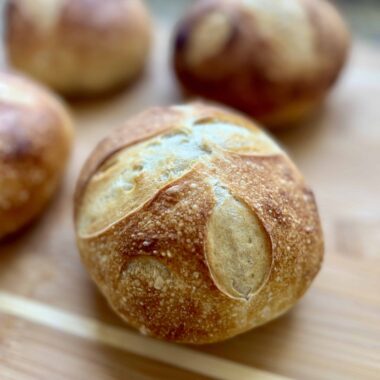
Sourdough Bread Bowls
Ingredients
Levain (10-12 hours, overnight)
- 22 grams ripe/active starter
- 220 grams all purpose or bread flour
- 220 grams water
Bread Bowl Dough
- 450 grams ripe levain
- 800 grams water
- 1200 grams bread flour see recipe notes
- 24 grams salt
- 2-4 cups ice cubes for baking the bread
Instructions
Mix Levain (1:10:10 ratio, 10-12 hours before peak)
- To a clear liquid measuring cup add 22 grams of starter, 220 grams of water and 220 grams of flour. Mix together. Cover and let sit at warm room temperature (78 F) for about 10-12 hours until the mixture has doubled in size. Once the levain has doubled in size, is bubbly and active and has reached it's peak height, it is ready to use.
Bread Bowl Dough
- Mix 450 grams of ripe levain, water, flour and salt in a bowl using a wooden spoon or dough whisk (affiliate link). The dough will look “shaggy” but will come together.
- Bulk Fermentation (4-5 hours): Cover the bowl and let it sit for an hour. After an hour, uncover the bowl and do a series of three "stretch and folds". To do this, pick up the underside of the dough and fold it on top of itself, turning the bowl after each fold and picking up a different section of the dough to fold and turn.
- Cover the bowl again and let it rest for another hour. Notice how the dough is coming together. It doesn’t feel shaggy anymore and is becoming more stretchy and cohesive. For the second time, do the series of three stretch and folds.
- Cover the bowl again and let it rest for another hour. Repeat the series of three stretch and folds. Let the dough rest at 78 degrees F until it has sat for a total of 4-5 hours. The dough will have risen about 30-40%, will have a few bubbles scattered around the top and will start to pull away from the edges and dome in toward the center of the bowl. If you don't notice these signs, let the dough continue bulk fermenting until you do notice them.
- Cold Fermentation: Cover the bowl with plastic wrap or a lid and put it in the refrigerator to rest overnight. The dough can stay in the refrigerator for 8 to 48 hours. See recipe notes for instructions on baking the same day.
- Shape the Bread Bowls: Take the dough out of the fridge. Separate into 10 pieces, about 240 grams each. If you prefer larger bread bowl, separate into 8 pieces. Use a bench scraper and wet fingers to shape each piece into a round ball. Tuck the dough under itself, turn, create tension and shape into a round ball.
- Prepare two pieces of parchment paper the size of the baking stone. Place five balls of dough on one piece of parchment paper. Repeat with the other five balls. Let the dough rest for 1-2 hours.
- Prepare the Oven: Put a baking stone in the oven and pre-heat the stone and oven to 475 degrees for about 30-45 minutes.
- Scoring: After the oven has pre-heated, score each ball of dough with a bread lame.
- Baking (20-30 minutes per batch): Place a pan filled with 1/2 – 1 cup of ice cubes on the bottom rack of the oven. Using a pizza peel or large cutting board, launch the five dough balls into the oven, on top of the pizza stone. Reduce temperature to 450 degrees F. Bake for 15 minutes without opening the oven. After 15 minutes remove the pan from the oven. Bake for another 10-15 minutes until desired color.
- To bake the second batch, pre-heat the oven and baking stone for about 10 minutes before baking the next batch. Add more ice and bake the last bread bowls.
- Let bread bowls cool completely before cutting open. Cut into the bread bowl at an angle and cut out the top. Use your fingers to pull out the inside of the bread, leaving the crust to serve as a bowl. Ladle soup into the bread bowl and enjoy!

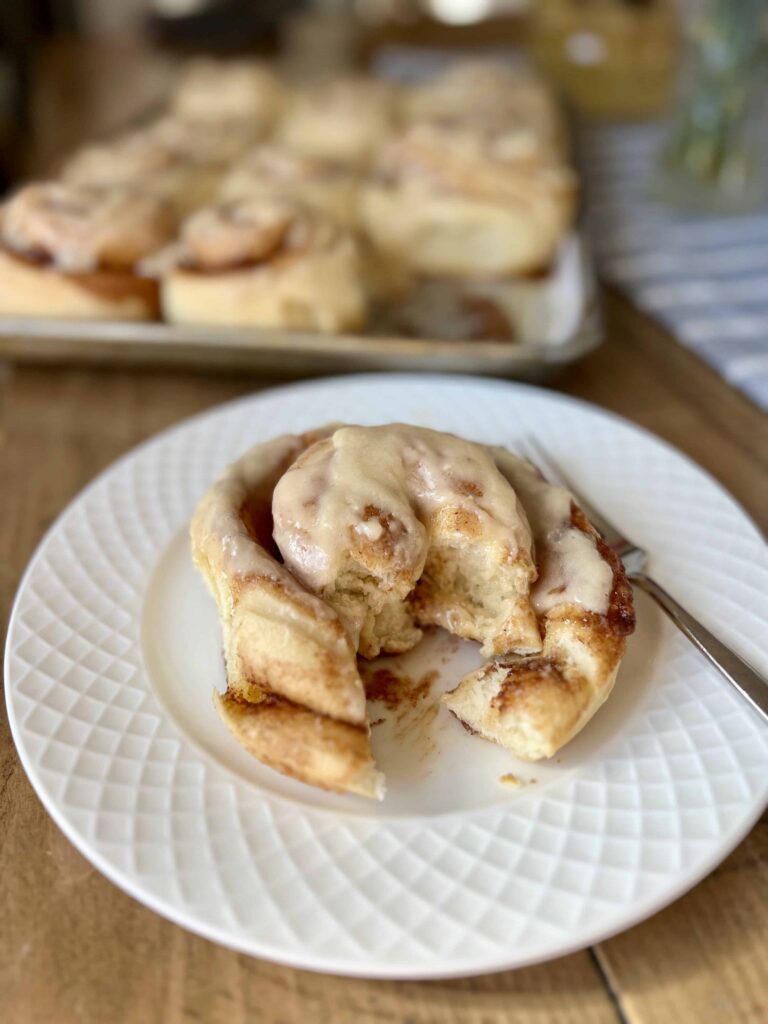
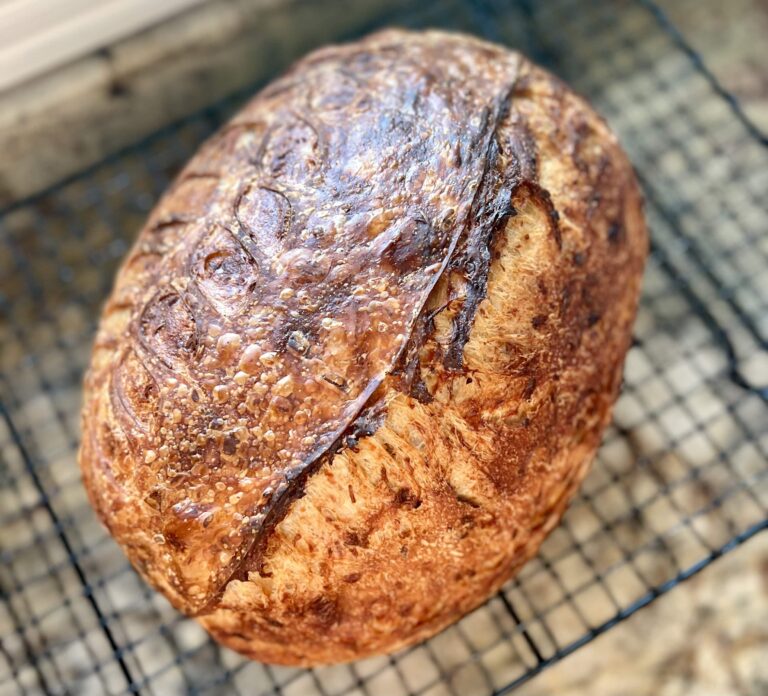
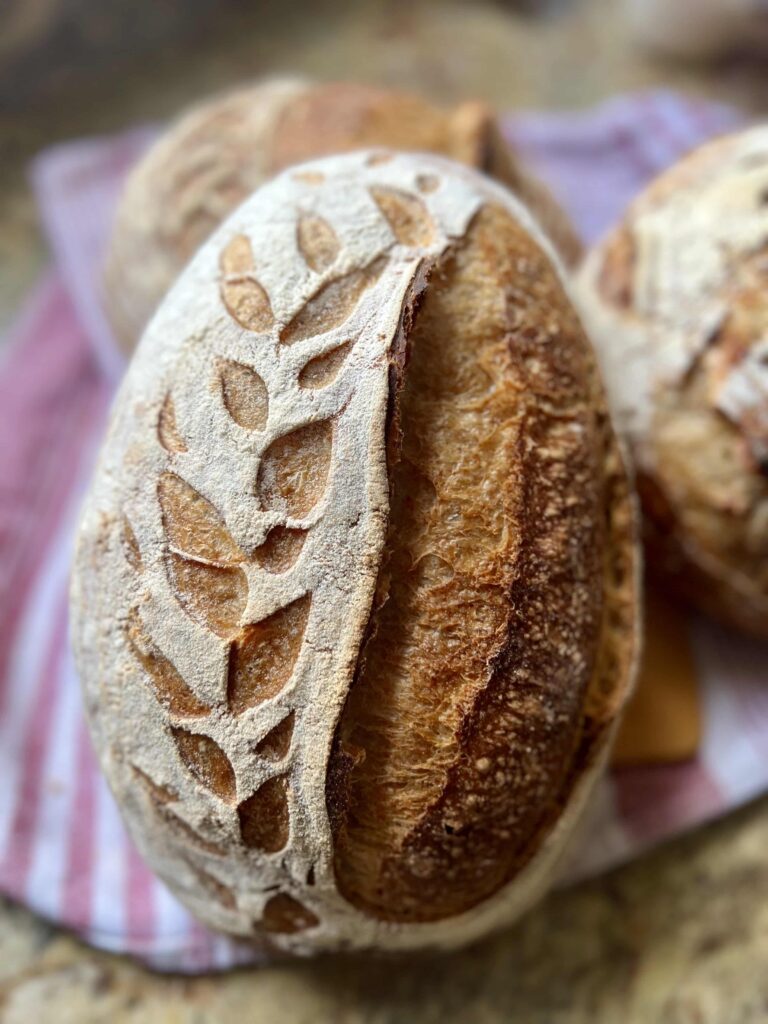

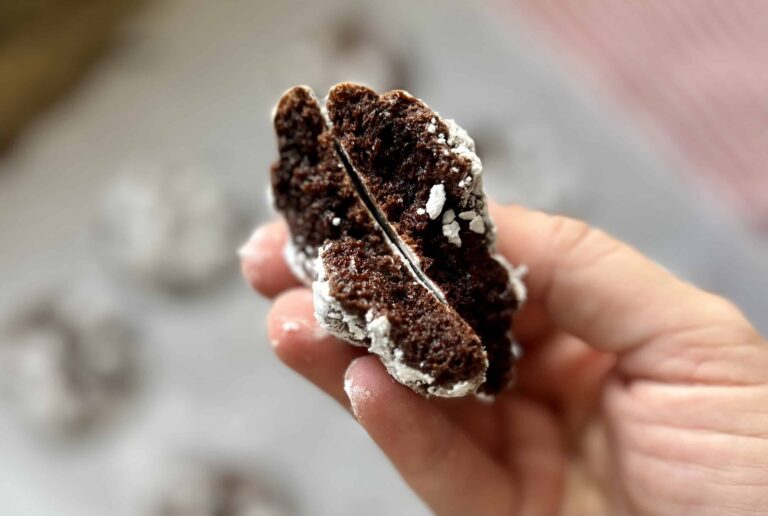
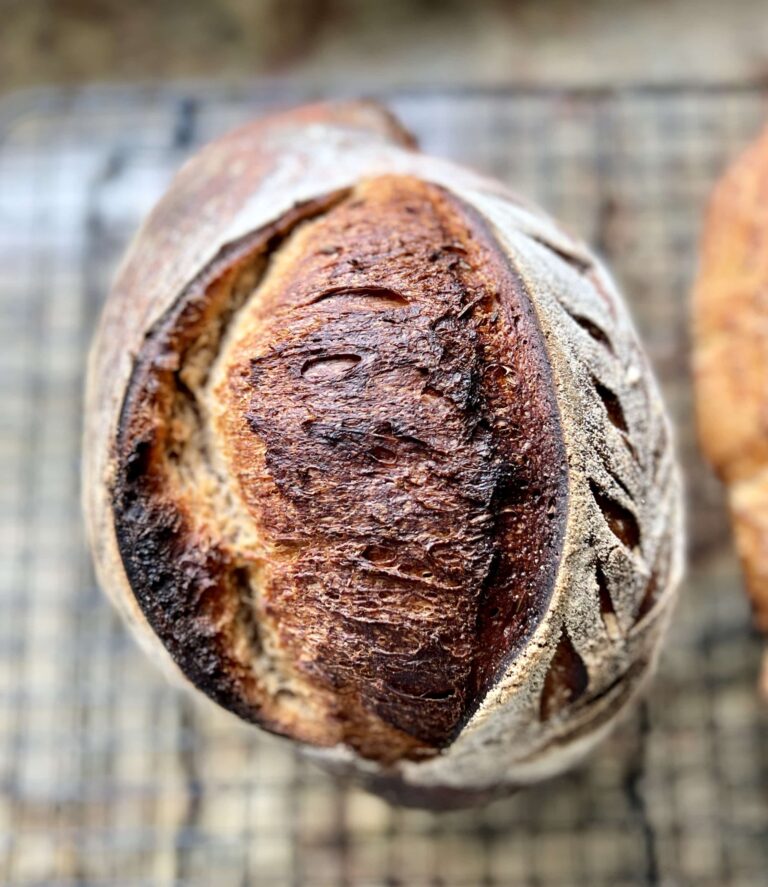
These definitely remind me of our San Francisco days! Thanks for sharing! 🍞🥣🌉🌁
How did you get your crust to blister and look shiny? Mine were dark and dry looking on top.
It’s in the fermentation time and the baking. Make sure the dough has fermented long enough, you may need to extend bulk fermentation a bit or the time it’s sitting on the counter before baking. If that’s not an issue, then it has to do with how it’s baked and making sure the oven is hot enough and has enough steam. I usually put ice cubes in the bottom of my oven for baking this and that helps the crust get shiny and blistery.
thank you 🙂
On step 7 are they resting at room temp or back in the fridge?
Resting at room temperature.